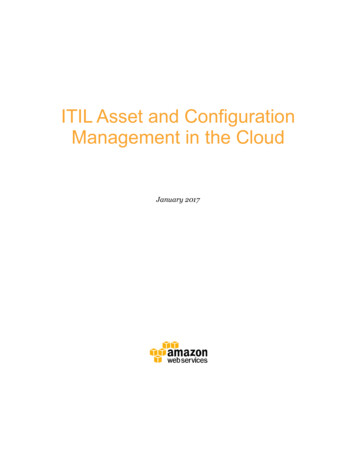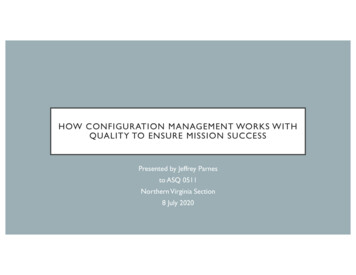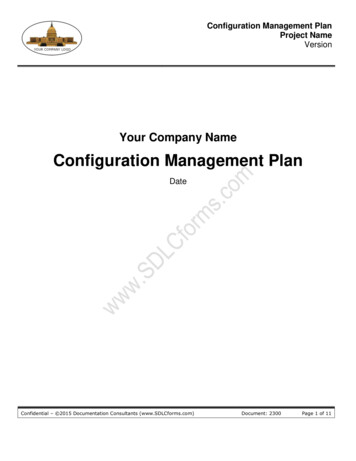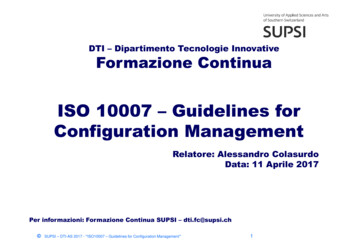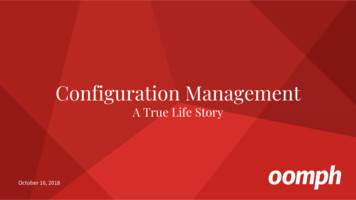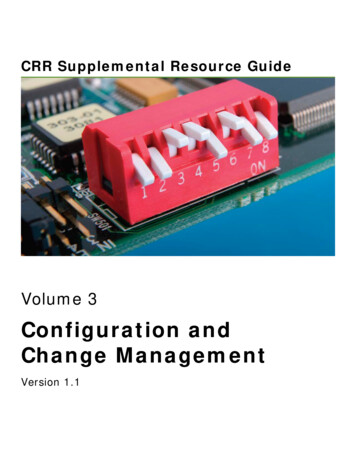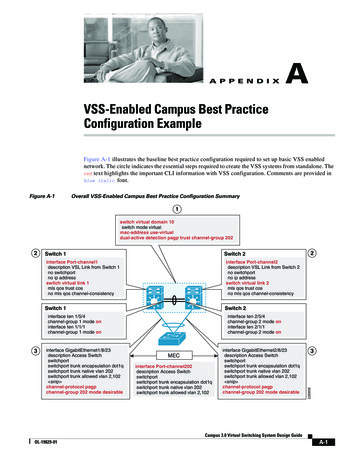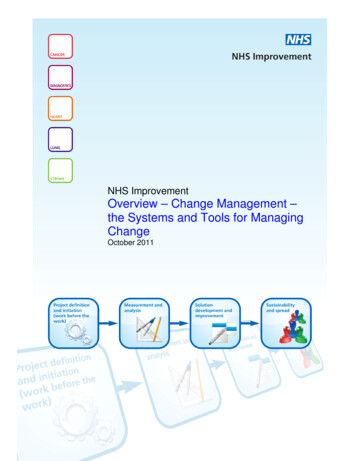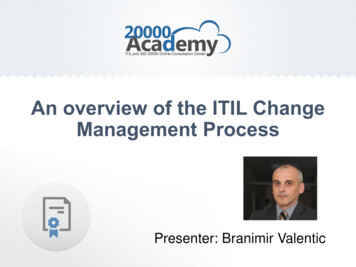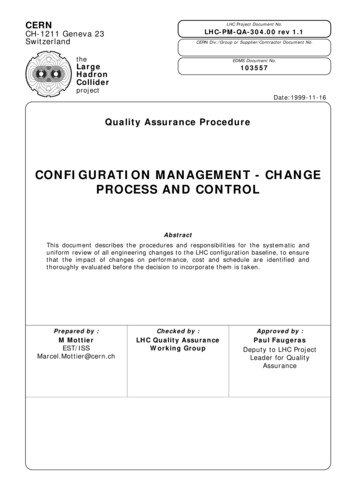
Transcription
CERNLHC Project Document No.LHC-PM-QA-304.00 rev 1.1CH-1211 Geneva 23SwitzerlandCERN Div./Group or Supplier/Contractor Document No.theEDMS Document Quality Assurance ProcedureCONFIGURATION MANAGEMENT - CHANGEPROCESS AND CONTROLAbstractThis document describes the procedures and responsibilities for the systematic anduniform review of all engineering changes to the LHC configuration baseline, to ensurethat the impact of changes on performance, cost and schedule are identified andthoroughly evaluated before the decision to incorporate them is taken.Prepared by :Checked by :Approved by :M MottierEST/ISSMarcel.Mottier@cern.chLHC Quality AssuranceWorking GroupPaul FaugerasDeputy to LHC ProjectLeader for QualityAssurance
LHC Project Document No.LHC-PM-QA-304.00 rev 1.1Page 2 of 21History of ChangesRev. No.DatePagesDescription of Changes0.11998-06-171st draft0.21998-07-30Update following QAPWG on of reference in section 9
LHC Project Document No.LHC-PM-QA-304.00 rev 1.1Page 3 of 21Table of Contents1.PURPOSE . 42.SCOPE. 43.POLICY . 44.RESPONSIBILITIES . 45.DEFINITIONS . 56.6.16.2INTRODUCTION TO CONFIGURATION BASELINE AND CHANGE CONTROL5BASELINE. 5CHANGE CONTROL. 67.7.17.27.3SELECTION OF CONFIGURATION ITEMS . 6HARDWARE ITEMS . 7PARAMETERS . 7DOCUMENTS. 88.8.18.28.38.4CHANGE PROCESS AND CONTROL . 8CORRECTION OF TRANSCRIPTION ERRORS. 8CHANGE REQUEST. 9ECR PREPARATION. 9ECR EVALUATION . 98.4.18.4.28.58.68.78.7.18.7.28.89.IMPACT ON COST, SCHEDULE AND TECHNICAL PERFORMANCE .11IMPACT ON RELATED ITEMS .11CLASSIFICATION OF CHANGES .13PROCESSING CLASS I CHANGES .13PROCESSING CLASS II CHANGES.13NORMAL PROCEDURE.13SIMPLIFIED PROCEDURE .14NOTIFICATION OF CLASS I CHANGE COMPLETION .14RELATED DOCUMENTATION . 1410. ANNEXES . 14
LHC Project Document No.LHC-PM-QA-304.00 rev 1.1Page 4 of 211. PURPOSETo provide a procedure for the systematic and uniform review of all engineeringchanges to the LHC configuration baseline, to ensure that the impact of changes onperformance, cost and schedule are identified and thoroughly evaluated before thedecision to incorporate them is taken.2. SCOPEThis procedure is applicable to:! All the hardware assemblies, sub-assemblies and parts of the LHC systems that areincluded in the Project Breakdown Structure (PBS) of the Project.! All the critical measuring and test equipment required to manufacture, install andverify the performance of the LHC.! All the main parameters defining the LHC and the injector chain layouts and beamperformance.! All the LHC systems parameters that have an effect on the LHC performance.! All the LHC systems parameters which may affect the LHC performance throughindirectly induced changes on other systems. (See " Documents and ParametersProcess and Control" [ 1 ] ).3. POLICYConfiguration management (CM) is the management process that ensures thatconsistency is maintained among the parameters, the requirements, the physical andfunctional configuration of the LHC and its documentation, particularly as changes aremade throughout the LHC life-cycle.The CM process ensures the integrity of the LHC systems and components during theirdesign, procurement, installation, operation and maintenance life-cycle stages.CM is applied to the parameters, systems, components, instructions and procedureswhose failure to satisfy requirements could lead to violations of safety requirements;non-compliance with regulations; significant loss of research capability; significantchanges in cost or schedule.CM is applied using a graded approach. A graded approach means that the depth andrigor of details necessary and the magnitude of resources required to carry-out the CMprocess are commensurate with the relative importance of systems, components,instructions and procedures in terms of safety, performance, cost, and complexity.4. RESPONSIBILITIESThe Technical Co-ordination Committee Chairman has the responsibility for all aspectsof configuration management.The Parameters and Layouts Committee Chairman has responsibility for theconfiguration management of the Project level parameters and layouts(see " Documents and Parameters Process and Control "[ 1 ], section 7.2.1).Project Engineers (PE) in charge of systems, sub-systems, assemblies and parts areresponsible for:! Verifying that the structure of the systems, sub-systems, assemblies and parts forwhich they are responsible are correctly represented in the LHC PBS andmaintained up to date.
LHC Project Document No.LHC-PM-QA-304.00 rev 1.1Page 5 of 21! Verifying that the configuration baseline documents of the systems, sub-systems,assemblies and parts for which they are responsible are stored in the EngineeringData Management System and maintained up to date.! Managing engineering change proposals in accordance with the proceduresdescribed in this document.! Defining appropriate configuration management procedures to be applied duringthe fabrication, assembly, test and installation phases of systems, sub-systems,assemblies and parts.5. DEFINITIONSConfiguration:The functional and physical characteristics ofhardwareasdescribedintechnicaldocumentation and achieved in a product.Configuration Management (CM):The systematic evaluation, co-ordination,review, approval or disapproval, documentationand implementation of all proposed changes inthe configuration of a product, after formalestablishment of its configuration baseline.Configuration Items (CI):Configuration items are the basic units ofconfiguration management. They may vary incomplexity, size and type, from a cryo-magnetassembly to a coil spacer. Regardless ofcomplexity, type or size, the configuration of aCI is documented and controlled.Configuration Baseline:The set of approved and released documentsthat represent the definition of a product at aspecific point in time. Configuration baselinesare established whenever it is necessary todefine a reference configuration during theproduct's life-cycle. This baseline is then usedas a starting point for further activities.Engineering Change:Any design change that will require a revisionof the Configuration Baseline and associateddocuments. This includes changes that willimpact the cost, schedule and performance ofthe LHC.Engineering Change Request (ECR):A document used to propose an engineeringchange.Engineering Change Order (ECO):A document used to implement an approvedengineering change.Engineering Change Notification (ECN) A document used to notify individuals that anapproved engineering change is implemented.6. INTRODUCTION TO CONFIGURATION BASELINE AND CHANGECONTROL6.1 BASELINEThe LHC configuration baseline is the set of approved and released parameters anddocuments that represent the definition of the LHC as it is designed.
LHC Project Document No.LHC-PM-QA-304.00 rev 1.1Page 6 of 21This "as-designed" configuration baseline is established as a reference configuration. Itcan then be used to follow the evolution of the Project through its life-cycle phases,design, procurement, installation, commissioning, and finally operation andmaintenance.At the end of the design phase the configuration baseline will contain all the drawings,specifications and manufacturing procedures necessary to manufacture, assemble,install and commission the LHC.When the installation is completed the "as-designed" configuration baseline,incorporating all the changes required during the construction, will represent the LHCas it will have been built. It will also include the measured main characteristics ofsystems and components useful for operation and maintenance.This "as-built" configuration will then be used as a reference to follow the evolution ofthe machine during its operating phase.6.2 CHANGE CONTROLAs the Project advances the technical requirements become better defined as a resultof the design and development activity, and technical changes have to be considered.It is the role of the engineering change control procedure to ensure that the changesare consistently reviewed, approved or rejected, implemented and reported.The procedure defines the items to control and a method to:! Ensure that changes to the configuration baseline are well defined, documented andapproved before implementation.! Ensure that decisions are made at the appropriate management level.7. SELECTION OF CONFIGURATION ITEMSSelected items of the LHC systems hardware or software (or combination of both),which need to have their configuration managed, are designated as configurationitems.Configuration items are the basic units of configuration management. They may varyin complexity, size and type, from a cryo-magnet assembly to a coil spacer.Regardless of complexity, type or size, the configuration of a CI is documented andcontrolled.Not all assemblies and parts require the same level of configuration control. The morecritical an item is, in terms of machine performance, reliability and safety, the moreimportant it is to be able to trace its characteristics and history. This is valid whetherthe item is a complex assembly or a single component.During the design phase of the Project, configuration management is applied to all theitems listed in the PBS and their associated design and contracting data anddocuments.During the production and installation phases, configuration management is appliedselectively, the level of detail being commensurate with the criticality of the items.For critical items produced in series, it may be necessary to keep track of the fullydetailed bill of materials and of all the manufacturing, measurements and test data, ofeach individual unit. For non-critical items a sampling procedure may be adequate.The Project Engineers in charge of systems, sub-systems, assemblies and parts shallestablish, with the assistance of the Technical Coordination Committee, theappropriate level of configuration management to be applied to their equipment.
LHC Project Document No.LHC-PM-QA-304.00 rev 1.1Page 7 of 21Figure 1: Configuration Management and Life-Cycle Phases7.1 HARDWARE ITEMSThe LHC Project configuration items comprises:! All the hardware assemblies, sub-assemblies and parts of the LHC systems that areincluded in the Project Breakdown Structure (PBS) of the Project.! All the critical measuring and test equipment that are included in the PBS.7.2 PARAMETERS1.All the main parameters defining the LHC and the injector chain layouts andbeam performance.2.All the LHC systems parameters that have an effect on the LHC performance.3.All the LHC systems parameters that have an effect on the design of other LHCsystems.The definitions in points 2 and 3 above apply to the following LHC systems:! Magnet.! Cryogenic.
LHC Project Document No.LHC-PM-QA-304.00 rev 1.1Page 8 of 21! Powering.! Vacuum.! Survey.! Beam losses and cleaning.! RF and feedback.! Injection and transfer lines.! Ejection and dump.! Instrumentation and controls.7.3 DOCUMENTSThe following document types that describe the parameters, assemblies, subassemblies and parts listed in points 1, 2 and 3 above:! Functional specifications.! Interface specifications.! Technical Description for Market Surveys.! Technical Specifications (Technical Description for Invitations to Tender and forPrice Enquiries).! Engineering Drawings.! Schedules.This list shall be completed as appropriate with the reports established during thefabrication, assembly, test and installation phases of configuration items.8. CHANGE PROCESS AND CONTROL8.1 CORRECTION OF TRANSCRIPTION ERRORSDespite the use of review and approval procedures to ensure that parameters anddocuments are checked prior to their release, errors and omissions may occur. Thereason maybe a typing mistake; the omission of a word or sentence; a technicalproblem when translating a document from the native text processing software to theon-line format used for distribution on the Web; or any other cause. All errors of thistype are identified as transcription errors.Once a parameter table or a document has been released it may be read, printed andcopied. Any correction requires that the revised parameter table or document bereleased once more with a new revision index.To clearly set apart correction of transcription errors from real engineering changesthe following rules shall apply:! Corrections of transcription errors are carried under the sole responsibility of theparameter table or document author.! Transcription errors are documented in the parameter table or document changehistory as "Minor correction".! The correction of a transcription error is the only case where a new revision of abaseline parameter table or document may be released without the change beingdocumented by an ECR.
LHC Project Document No.LHC-PM-QA-304.00 rev 1.1Page 9 of 218.2 CHANGE REQUESTThe change control procedure is shown on fig. 2.The change process starts when a proposal for a change is formulated. Any competentperson involved in the Project, at CERN, Institutes or Contractors, may propose achange. Before the formal change process is started with the preparation of anEngineering Change Request (ECR) it is recommended that the originator discuss theproposal with the responsible Project Engineer or the PLC Chairman. This exchange ofideas shall establish how the proposed change should be processed. The possibilitiesare:A.The originator of the proposal, together with the responsible PE or the PLCChairman, agree that the justification for the change is inadequate and shouldnot be pursued.B.The responsible PE, or the PLC Chairman, is able to assess, without a formal ECRevaluation, that the change is of low-impact (as defined in section 8.4.1) and islocal (as defined in section 8.4.2). In that case, the PE or the PLC Chairman hasthe choice to :– Go ahead with a formal ECR or– Apply the simplified procedure described in section 8.7.2.C.The change proposal requires a full evaluation, an ECR shall be prepared.Cases which cannot be decided by the responsible PE, or the PLC Chairman, shall bereferred to the TCC Chairman.8.3 ECR PREPARATIONThe LHC Project formal change process is initiated by the preparation of an ECRdocument completed by the originator of the proposal, with the assistance of eitherthe PE in charge of the affected hardware item or the PLC Chairman as appropriate.PE's and designers of items and parameters affected by the change may be calledupon to assist with the ECR preparation.Once ready the ECR shall be forwarded to:! The PE in charge of the affected item in the case of hardware changes.! The PLC Chairman in the case of parameter changes.In cases where a Contractor proposes an engineering change, the CERN's technicalcontact person shall prepare the ECR.Changes affecting both parameters and hardware items shall be forwarded to the"Technical Coordination Committee" Chairman.ECR are managed as described in "Documents and Parameters Process and Control" [1 ], and they shall be prepared in accordance with the "Instructions for the completionof ECR's"[ 2].8.4 ECR EVALUATIONThe PE or the PLC Chairman, in collaboration with PE's and Project Committeesresponsible for items affected by the proposal, shall first examine the merits of theproposed change, and decide whether to go ahead with a detailed evaluation or toreject the proposal.In case the proposal is rejected at that stage, the PE or the PLC secretary shall informthe originator of the decision.If the ECR is considered valid, it shall be evaluated to determine:
LHC Project Document No.LHC-PM-QA-304.00 rev 1.1Page 10 of 21! The impact on cost, schedule or technical performance.! The impact on related items in the PBS.Figure 2: Change Process and Control Diagram
LHC Project Document No.LHC-PM-QA-304.00 rev 1.1Page 11 of 218.4.1 IMPACT ON COST, SCHEDULE AND TECHNICAL PERFORMANCEFor the purpose of change control, impact on cost, schedule and technicalperformance shall be classified as low impact or high impact based on the criteriagiven in table 1.CostSchedulePerformanceLow impactChange of less thanCHF 200'000.-Less than 1 monthdeviation on LHCcompletion targetdateLess than 5%deviation fromfunctionalrequirementsHigh impactChange ofCHF 200'000.- ormore1 month or moredeviation on LHCcompletion targetdate5% or more deviationfrom functionalrequirementsTable 1: Definition of Impact on Cost, Schedule and PerformanceWhen using table 1 the impact on cost, schedule and performance shall be comparedindividually to each of the criteria. It is sufficient that one of the high impact criteriabe met to determine that the change is high impact.Ii may be difficult for a PE to evaluate all the implications of a change. If this is thecase the PE may seek the assistance of his supervisor and of Project Committees incarrying out the impact assessment.8.4.2 IMPACT ON RELATED ITEMSThe second step of the evaluation shall establish whether the change's impact isextended or local.Extended changes are changes affecting:! LHC systems parameters.! Principal items and their parent items in the LHC PBS.! Identical child items of principal item attached to two or more principal items.Local changes are changes affecting:! one or more child items of a single principal item.An extract of the PBS is shown in fig. 3 with examples of principal and child items.Figure 3: Principal and Child Items in the PBS
LHC Project Document No.LHC-PM-QA-304.00 rev 1.1Page 12 of 21When evaluating the extent of a change the interchangeability of the affected itemsshall be evaluated as well.Interchangeability is defined as follows:! Two or more parts or assemblies are considered interchangeable if, in allapplications, they are:! Of an acceptable form and appearance to fulfil all requirements defined inthe specification.! Of a proper fit (physical dimensions) to assemble with other mating items.! Of a proper function to meet the item specification.Parts and assemblies meeting these criteria are completely interchangeable,one for the other (both ways) with no special adjustments, modifications, oralterations to themselves or to related parts and assemblies.The reference to all applications means that when a part or a assembly isused in more then one parent assembly the evaluation of interchangeabilitymust be done for each different assembly.When evaluating the interchangeability of the children of a principal item the analysismust be done recurrently for all the children up to the principal item until it is foundthat the item is interchangeable.If the analysis shows that the principal item becomes non-interchangeable as a resultof the change, the change becomes an extended change.The process of interchangeability analysis is shown on fig. 4.Figure 4: Interchangeability Evaluation Diagram
LHC Project Document No.LHC-PM-QA-304.00 rev 1.1Page 13 of 218.5 CLASSIFICATION OF CHANGESThe use of classes makes it possible to adapt the change process to the evaluatedimpact of changes and to minimize the effort required to process the change.Two classes of changes are defined as follows:CLASS IMajor change-Non-interchangeable hardware modifications andchanges with a significant impact on cost, schedule or technicalperformance.CLASS IIMinor change-Interchangeable hardware modifications and changeswith a low impact on cost, schedule or technical performance.Based on the evaluation of the impact of a change and its extent, the change class canbe determined the definitions in table2.Local changeExtended changeLow impact changeCLASS IICLASS IHigh impact changeCLASS ICLASS ITable 2: Change class definition8.6 PROCESSING CLASS I CHANGESOnce the evaluation is complete the PE shall update the ECR with:! The impact, extent and resulting CLASS of the change.! His recommendation on the acceptance or refusal of the change.! The list of actions necessary to implement the change.! His name and the date of the recommendation.The ECR shall then be forwarded to the appropriate Committee Chairman and/orApproval Group Leader. The Committee Chairman and/or Approval Group Leader shallthen forward the ECR to Committee members and/or Approval Group members with arequest for comments.At the end of the time allocated for the submission of comments the CommitteeChairman and/or Approval Group Leader shall review the comments ant take the finaldecision of approval or rejection of the ECR. He shall then update the ECR with:! The final decision of acceptance or refusal of the change.! His name and the date of the decision.The completed ECR is used as an ECN to inform all the involved individuals of theapproved change. The involved persons are:! The members of the Committee and/or the members of the Approval Group.! The PE in charge of the parent and child items of the affected item in the PBS.! The PE's design team members.The completed ECR is also forwarded as an ECO to all individuals in charge of theimplementation of the change.8.7 PROCESSING CLASS II CHANGES8.7.1 NORMAL PROCEDUREOnce the evaluation is complete the PE shall update the ECR with:
LHC Project Document No.LHC-PM-QA-304.00 rev 1.1Page 14 of 21! The impact, extent and resulting CLASS of the change.! His decision on the acceptance or refusal of the change.! The list of actions necessary to implement the change.! His name and the date of the decision.The completed ECR is used as an ECN to inform all the involved individuals of theapproved change. The involved persons are:! The PE in charge of the parent and child items of the changed item in the PBS.! The PE's design team members.The completed ECR is also forwarded as an ECO to all individuals in charge of theimplementation of the change.8.7.2 SIMPLIFIED PROCEDUREThe simplified procedure may be applied only for low-impact changes that arelocalised to a single item of the PBS, with no effect whatever to other PBS items. Toensure the traceability of change following this procedure, particular care shall betaken to accurately describe the change in modified drawings and documents.The PE responsible for the item shall:! Instruct the design office to make the necessary modifications to CAD models anddrawings. The precise nature of the modification shall be entered in each drawing'smodification list.! Instruct authors of documents, in particular engineering specifications, to make thenecessary changes. The precise nature of the modification shall be entered in eachdocument's change history.! Submit the drawings and documents to the appropriate review and approvalprocess.! Notify the PE responsible for the parent item in the PBS.8.8 NOTIFICATION OF CLASS I CHANGE COMPLETIONWhen all the necessary actions to implement a CLASS I ECO are completed the PE incharge of the implementation shall:! Update the ECO with his name and the date of the completion.! Notify the person who authorised the change of the completion.9. RELATED DOCUMENTATION[ 1 ] LHC-PM-QA-303.00Documents and Parameters Process and Control[ 2 ] LHC-PM-QA-608.00Instructions for the completion of ECR's10. ANNEXESA.1ECR document cover page.A.2Extract of the LHC Project Breakdown Structure.(For the current up-to-date version of the PBS ct LHC&action start) .
LHC Project Document No.LHC-PM-QA-304.00 rev 1.1Page 15 of 21&(51/ & 3URMHFW 'RFXPHQW 1R & *HQHYD 6ZLW]HUODQG GRF QR @('06 'RFXPHQW 1R (QJLQHHULQJ &KDQJH UHTXHVWHG E\ 1DPH 'LY *US WKH/DUJH DGURQ&ROOLGHU 1DPH@ 'LY *US @SURMHFW'DWH(QJLQHHULQJ &KDQJH 5HTXHVW &ODVV ,%ULHI GHVFULSWLRQ RI WKH SURSRVHG FKDQJH V(TXLSPHQW FRQFHUQHG'UDZLQJV FRQFHUQHG'RFXPHQWV FRQFHUQHG3( LQ FKDUJH RI WKH LWHP3( LQ FKDUJH RI SDUHQW LWHP LQ 3%6'HFLVLRQ RI WKH 3URMHFW (QJLQHHU'HFLVLRQ RI WKH 3/2 IRU &ODVV , FKDQJHV ; 5HMHFWHG ; FFHSWHG E\ 3URMHFW (QJLQHHU QR LPSDFW RQ RWKHU LWHPV FWLRQV LGHQWLILHG E\ 3URMHFW (QJLQHHU ; FFHSWHG E\ 3URMHFW (QJLQHHU ; 1RW UHTXHVWHG ; 5HMHFWHG ; FFHSWHG E\ WKH 3URMHFW /HDGHU 2IILFH FWLRQV LGHQWLILHG E\ 3URMHFW /HDGHU 2IILFHEXW LPSDFW RQ RWKHU LWHPV &RPPHQWV IURP RWKHU 3URMHFW (QJLQHHUV UHTXLUHG)LQDO GHFLVLRQ DFWLRQV E\ 3URMHFW 0DQDJHPHQW'DWH RI SSURYDO'DWH RI SSURYDO FWLRQV WR EH XQGHUWDNHQ'DWH RI &RPSOHWLRQ9LVD RI 4 2IILFHU1RWH ZKHQ DSSURYHG DQ (QJLQHHULQJ &KDQJH 5HTXHVW EHFRPHV DQ (QJLQHHULQJ &KDQJH 2UGHU 1RWLILFDWLRQ Annex A1: ECR Document Cover Page.
LHC Project Document No.LHC-PM-QA-304.00 rev 1.1Page 16 of 21Large Hadron Collider1 Infrastructure & General Machine Services1.1 Civil Engineering Infrastructure1.2 Electrical Distribution Network1.2.1 AC Mains Network1.2.2 DC Network Schematics1.3 Control & Data Network1.4 Fluid Networks1.4.1 Air Ventilation1.4.2 Water Cooling1.5 Ring Cryogenic System1.6 Tunnel Transportation Equipt & Infrastructure1.7 Survey Equipt2 Arc & Dispersion Suppressor Equipt & Facilities2.1 Cryo Distribution Line2.1.1 Supporting System2.1.2 Standard Pipe Sections2.1.3 Compensation Modules2.1.4 Service Modules2.1.5 QRL Jumpers2.1.6 Return Box2.2 Cryo Magnets2.2.1 Cryo Dipoles2.2.1.1 Cold Mass Assembly2.2.1.1.1 Collared Coil2.2.1.1.2 Spool Pieces2.2.1.1.3 Bus Bars2.2.1.1.4 Yoke & related Components2.2.1.1.5 Shrinking Cylinder & related Equipt2.2.1.1.6 Quench Diode Assembly2.2.1.1.7 Cold Bore Pipes & Insulation2.2.1.1.8 Beam Screens2.2.1.1.9 Heat Exchanger Tube2.2.1.1.10 Cold Mass Instrumentation Equipt2.2.1.2 Dipole Cryostat & related Equipt2.2.1.2.1 Vacuum Vessel2.2.1.2.2 Thermal Shield2.2.1.2.3 Radiation Screen2.2.1.2.4 Multi Layer Insulation2.2.1.2.5 Support Systems2.2.1.2.6 Cryostat Instrumentation & Capillaries2.2.1.2.7 Vacuum Tank Support System2.2.1.2.8 Survey Reference Sockets2.2.1.2.9 Fastening Devices for Transportation2.2.2 Standard Arc Short Straight Sections2.2.2.1 SSS Cold Mass Assembly2.2.2.1.1 Lattice Quadrupole2.2.2.1.1.1 Collared Coils2.2.2.1.1.2 Yoke & related Components2.2.2.1.2 Inertia Tube & Flange Assembly2.2.2.1.3 Combined Sextupole-Dipole Magnet2.2.2.1.4 Octupole Corrector2.2.2.1.5 Tuning Quadrupole2.2.2.1.6 Skew Quadrupole2.2.2.1.7 Mounting Devices for Correctors2.2.2.1.8 Electrical Connections2.2.2.1.9 Bus Bars2.2.2.1.10 Quench Diode Assembly2.2.2.1.11 Cold Bore Pipes & Insulation2.2.2.1.12 Beam Screens2.2.2.1.13 Heat Exchanger Tube2.2.2.1.14 Cold Mass Instrumentation Equipt2.2.2.2 SSS Cryostat & related Equipt2.2.2.2.1 SSS Vacuum Vessel Assembly2.2.2.2.2 Thermal ShieldLyn EVANSPaul FAUGERASJ.-Luc BALDYGunnar FERNQVISTJohn PEDERSENPaul PROUDLOCKRobin LAUCKNERMats WILHELMSSONJean ROCHEBernard PIROLLETPhilippe LEBRUNKeith KERSHAWJean-Pierre QUESNELPaul FAUGERASWolfgang ERDTWolfgang ERDTWolfgang ERDTWolfgang ERDTWolfgang ERDTWolfgang ERDTWolfgang ERDTJean-Pierre GOURBERCarlo WYSSJos VLOGAERTDiego PERINIAlbert IJSPEERTJean-Louis PERINET-MARQUETDiego PERINIFrederic SAVARYDietrich HAGEDORNFrederic SAVARYOswald GROBNERLaurent Jean TAVIANJos VLOGAERTAlain PONCETLloyd Ralph WILLIAMSLloyd Ralph WILLIAMSLloyd Ralph WILLIAMSTore WIKBERGVittorio PARMALloyd Ralph WILLIAMSLloyd Ralph WILLIAMSJean-Pierre QUESNELLloyd Ralph WILLIAMSJean-Pierre GOURBERTheodor TortschanoffJean-Michel RIFFLETJean-Michel RIFFLETJean-Michel RIFFLETJean-Michel RIFFLETAlbert IJSPEERTAlbert IJSPEERTAlbert IJSPEERTAlbert IJSPEERTMichel GENETJean-Michel RIFFLETJean-Louis PERINET-MARQUETJean-Michel RIFFLETFrederic SAVARYOswald GROBNERLaurent Jean TAVIANTheodor TortschanoffPeter ROHMIGDaniel VINCENTDaniel BMMB ADCMB AMB CQVCSQQQAQQAAnnex A2 Extract of the LHC ProjectBreakdown Structure (page 1)
LHC Project Document No.LHC-PM-QA-304.00 rev 1.1Page 17 of 212.2.2.2.3 Radiation Screen2.2.2.2.4 Multi Layer Insulation2.2.2.2.5 Support Systems2.2.2.2.6 Cryostat Instrumentation & Capillaries2.2.2.2.7 Vacuum Vessel Support System2.2.2.2.8 Survey Reference Sockets2.2.2.2.9 Fastening Devices for Transportation2.2.2.2.10 Beam Loss Monitors2.2.2.3 Technical Service Module2.2.2.3.1 BPM & Beam Screen Assembly2.2.2.3.2 Cryogenic Components2.2.2.3.3 Insulation Vacuum Barrier System2.2.2.3.4 Dipole Corrector Current Feedthrough Assembly2.2.2.3.5 Cold Mass Instrumentation Feedthrough2.2.2.3.6 TSM Vacuum Vesse
Configuration Management (CM): The systematic evaluation, co-ordination, review, approval or disapproval, documentation and implementation of all proposed changes in the configuration of a product, after formal establishment of its configuration baseline. Configuration Items (CI): Configuration items are the basic units of configuration management.
![Change Management Process For [Project Name] - West Virginia](/img/32/change-20management-20process-2003-2022-202012.jpg)
